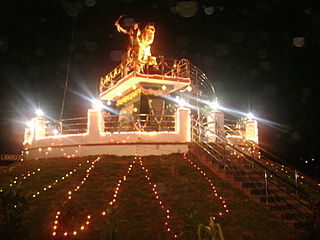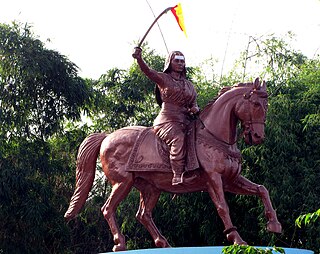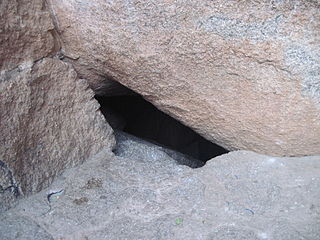Related Research Articles

Belagavi district, formerly also known as Belgaum district, is a district in the state of Karnataka, India. The district is known as the sugar bowl of Karnataka with 150,000 hectares being used for commercial production. It has overtaken Mandya district in sugarcane production over the last decade. The city of Belgaum (Belagavi) is the district headquarters in Belagavi district. It houses the Second legislative building, where the Karnataka Legislature hold session once a year. The district is famous for its native sweet, Kunda. According to the 2011 Census of India, it has a population of 4,779,661, of which 24.03% live in urban areas, making it the second most populous district in Karnataka, after Bangalore Urban. The district has an area of 13,415 km2 (5,180 sq mi) making it the largest district in Karnataka, and is bounded by Kolhapur District and Sangli district of Maharashtra state on the west and north, on the northeast by Bijapur district, on the east by Bagalkot district, on the southeast by Gadag district, on the south by Dharwad and Uttara Kannada districts, and on the southwest by the state of Goa.

Rajaram Bhonsle I was the third Chhatrapati of Maratha Empire, who ruled from 1689 to his death in 1700. He was the second son of the Shivaji, the founder of the empire and younger half-brother of Sambhaji, who he succeeded. His eleven-year reign was marked with a constant struggle against the Mughals. He was succeeded by his infant son Shivaji II under the regentship of his dowager Maharani Tarabai.
Bailhongal is a Taluk in Belagavi district of Karnataka state in southern India. Bailhongal Taluk is located towards the north-east part of Belagavi. The taluk headquarters is about 44 km from the district headquarters. The total geographical area of the taluk is 1122.40 km2. There are 126 revenue villages and 14 hamlets with a total population of 356,400 people, according to the 2001 census.

Kittur, historically as Kittoor, is a town in the Belagavi district of the Indian state of Karnataka. It was part of Bailhongal taluka but was declared as an independent taluka on 23 October 2012 by the Chief Minister of Karnataka on the inauguration of Kittur Utsav. It is 177th Taluk of Karnataka State. It is a place of historical importance because of the armed rebellion of Kittur Chennamma (1778–1829), Rani of the State of Kittur against the British East India Company, during which a British Commissioner, St John Thackeray was killed.

Kittur Chennamma was the Indian Queen of Kittur, a former princely state in present-day Karnataka. She led an armed resistance against the British East India Company, in defiance of the Paramountcy, in an attempt to retain control over her dominion. She defeated the Company in the first revolt, but died as a prisoner of war after the second rebellion. As one of the first and few female rulers to lead kittur forces against British colonisation, she continues to be remembered as a folk hero in Karnataka, she is also an important symbol of the Indian independence movement.

Onake Obavva was a Karnataka warrior who fought the forces of Hyder Ali single-handedly with a pestle (Onake) in the kingdom of Chitradurga of Karnataka, India. Her husband was a guard of a watchtower in the rocky fort of Chitradurga. In the state of Karnataka, she is celebrated along with Abbakka Rani, Keladi Chennamma and Kittur Chennamma, as the foremost women warriors and patriots. She belonged to the Holayas (Chalavadi) community. Government of Karnataka has taken up initiative to celebrate November 11 as Onake Obavva Jayanti since 2021.

Chitradurga is a city and the headquarters of Chitradurga district, which is located on the valley of the Vedavati river in the central part of the Indian state of Karnataka. Chitradurga is a place with historical significance which is located to the North West about 200 km from the state capital Bengaluru. Chitradurga is a major tourist hub in Karnataka.
Channagiri is a town in Davanagere district in the state of Karnataka, India. It is a taluk headquarters in Davanagere District from 1997. Before it was the part of Shivamogga District.
Nayakas of Chitradurga ruled parts of eastern Karnataka during the post-Vijayanagara period. During the rule of Hoysala Empire and Vijayanagara Empire, they served as a feudatory chiefdom. Later, after the fall of the Vijayanagara empire, they ruled at times as an independent chiefdom and at other times as a vassal of the Mysore Kingdom, Mughal Empire and Maratha Empire. Finally, their territories merged into the province of Mysore under the British.

Nayakas of Keladi (1499–1763), also known as Nayakas of Bednore and Ikkeri Nayakas, were an Indian dynasty based in Keladi in present-day Shimoga district of Karnataka, India. They were an important ruling dynasty in post-medieval Karnataka. They initially ruled as a vassal of the famous Vijayanagar Empire. After the fall of the empire in 1565, they gained independence and ruled significant parts of Malnad region of the Western Ghats in present-day Karnataka, most areas in the coastal regions of Karnataka and the central plains along the Tungabhadra river. In 1763 AD, with their defeat to Hyder Ali, they were absorbed into the Kingdom of Mysore. They played an important part in the history of Karnataka, during a time of confusion and fragmentation that generally prevailed in South India after the fall of the Vijayanagar Empire. The Keladi rulers were of the Vokkaliga and Banajiga castes and were Veerashaivas by faith. The Haleri Kingdom that ruled over Coorg between 1600 A.D and 1834 A.D. was founded by a member of the Keladi family.
Gangolli is a village in Kundapur Taluk of Udupi district in Karnataka state. It is situated at the estuary of the Panchagangavalli River. It is located on a peninsula on the west coast of Karnataka. It is bordered by the river to the east and by the Arabian Sea to the west.
Chennamma may refer to:

Rani Abbakka Chowta was the first Tuluva Queen of Ullal who fought the Portuguese in the latter half of the 16th century. She belonged to the Chowta dynasty, an indigenous Tuluva dynasty who ruled over parts of coastal Karnataka, India. Their capital was Puttige. The port town of Ullal served as their subsidiary capital. The Portuguese made several attempts to capture Ullal as it was strategically placed. But Abbakka repulsed each of their attacks for over four decades. For her bravery, she came to be known as Abhaya Rani. She was also one of the earliest Indians to fight European colonialism and is sometimes regarded as the 'first woman freedom fighter of India'. In the state of Karnataka, she is celebrated along with Rani Kittur Chennamma, Keladi Chennamma, Rani Chennabhairadevi and Onake Obavva, as the foremost women warriors and patriots.
The Kingdom of Mysore was a kingdom in southern India founded in 1399 by Yaduraya in the region of the modern city of Mysore, the Karnataka state. The Wodeyar dynasty ruled the Southern Karnataka region until Indian independence in 1947, when the kingdom was merged with the Union of India.
Sangolli is a village in Bailahongal taluk of Belgaum district Indian State of Karnataka, India. This is the birthplace of prominent warrior Sangolli Rayanna, from Karnataka, India. He was the army chief of the Kingdom of Kittur ruled at the time by Rani Chennamma and fought the British East India Company till his death. His life was the subject of the 2012 Kannada film Sangolli Rayanna.

The name Karnataka is derived from Karunadu, meaning 'lofty land' or 'high plateau', due to its location on the Deccan Plateau. The name can also mean 'land of black soil' in Kannada. There are other possible roots of the name. The recorded history of Karnataka goes back to the Ramayana and Mahabharata epics. The capital of "Baali" and "Sugriva" referenced in the Ramayana is said to be Hampi. Karnataka is mentioned in the Mahabharata as "Karnata Desha"." Historically, the region was also called "Kuntala Rajya".
Household stone implements in Karnataka, India used for wet grinding, dry grinding and pounding are oralu kallu, beeso kallu, dundagallu and kutni.
The study of women's history in the Indian subcontinent has been a major scholarly and popular field, with many scholarly books and articles, museum exhibits, and courses in schools and universities.

Swarajya Saudamini Tararani is an Indian Marathi language historical TV series which aired on Sony Marathi. It starred Swarda Thigale as Tararani in lead role. It is directed by Kartik Kendhe and produced by Amol Kolhe under the banner of Jagdamb Production. It premiered from 15 November 2021 and ended on 16 July 2022 completing 221 episodes.
References
- ↑ Kudva, Venkataraya Narayan (1972). History of the Dakshinatya Saraswats. Madras: Samyukta Gowda Saraswata Sabha. p. 112.
- 1 2 M G Agrawal (2008). Freedom Fighters of India (in Four Volumes). Isha Books. p. 192. ISBN 9788182054684.
- ↑ Krishnamurthy, Radha (1995). Sivatattva Ratnakara of Keladi Basavaraja: a cultural study. Keladi, Karnataka: Keladi Museum and Historical Research Bureau. pp. 6, 115.
- 1 2 Dixit, Giri S (1981). Studies in Keladi History: Seminar Papers. Bangalore: Mythic Society. pp. 4, 5, 115.
- ↑ "1671-96 Rani Regnant Chennamma of Keladi (or Bednur) (India)". Worldwise guide to women in leadership. Retrieved 13 November 2012.
- ↑ "Kannada Tv Serials Keladi Chennamma". nettv4u. Retrieved 10 December 2020.